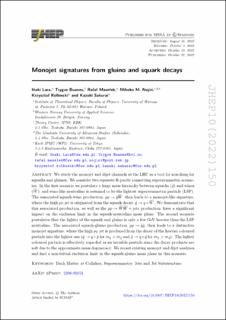| dc.description.abstract | We study the monojet and dijet channels at the LHC as a tool for searching for squarks and gluinos. We consider two separate R-parity conserving supersymmetric scenarios. In the first scenario we postulate a large mass hierarchy between squarks (q∼) and winos (W∼), and wino-like neutralino is assumed to be the lightest supersymmetric particle (LSP). The associated squark-wino production, pp → q∼W∼, then leads to a monojet-like signature, where the high pT jet is originated from the squark decay, q∼→ q + W∼. We demonstrate that this associated production, as well as the pp → W∼W∼+ jets production, have a significant impact on the exclusion limit in the squark-neutralino mass plane. The second scenario postulates that the lighter of the squark and gluino is only a few GeV heavier than the LSP neutralino. The associated squark-gluino production, pp → q∼g∼, then leads to a distinctive monojet signature, where the high pT jet is produced from the decay of the heavier coloured particle into the lighter one (q∼→ q+g∼ for mq~ > mg~ and g∼ → q+q∼ for mg~ > mq~). The lighter coloured particle is effectively regarded as an invisible particle since the decay products are soft due to the approximate mass degeneracy. We recast existing monojet and dijet analyses and find a non-trivial exclusion limit in the squark-gluino mass plane in this scenario. | en_US |

